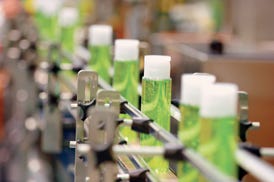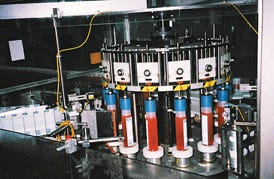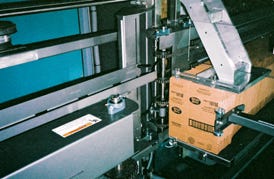
Surefil LLC is a Grand Rapids, MI-based company dedicated to providing custom filling solutions to the personal care and medical industries. Surefil provides formulation support, manufacturing, supply-chain management and logistics of branded personal care and medical liquids, lotions and gels. "Every industry is starting to think of manufacturing as a service," says Bill Hunt, CEO of Surefil. "Today, numerous marketing companies in multiple industries outsource their manufacturing."
Last April, Surefil installed a new, high-speed packaging line to service its contract-packaging customers. "The high speed and dependability were key considerations in selecting this new equipment," says Jeff Bevis, chief engineer for Surefil. "In addition, because of the diversity and number of different packages that we run, the line has to be extremely flexible and able to be quickly and easily changed from one package to another," he says. Surefil runs more than 75 different skus in 17 different packages, and that number is growing continually. Another new packaging line expected to be operational in January 2007 will add another 85 million units to Surefil's capacity.

Surefil worked closely with systems integrator Integrated Packaging Machinery (www.callipm.com) to design the new line. IPM developed the line layout, helped select equipment and assisted with the equipment installation. It also arranged the supply of the complete conveyor system including the vacuum conveyor from the bottle unscrambler to the filler/capper. In addition, IPM developed and installed the control sequence for the entire line, which has standardized on controls from Rockwell Automation (www.rockwell.com).
During PD's visit, the new line was running White Rain(R) Energizing Citrus shampoo in a 15-oz clear vinyl bottle supplied by GK Packaging, Inc. (www.gkpackaging.com) at a speed of 180 bottles/min. To start the operation, the bottles are dumped into a floor-level hopper of a Model NEHCP bottle unscrambler from New England Machinery, Inc. (www.neminc.com). An elevator drops them into a rotating bowl, from which the bottles enter a vertical wheel that sets them on the exit conveyor. If the bottle is in the proper orientation with the bottom leading, a finger mounted on the wheel slips off the bottom of the bottle.
However, if the open end is in the leading position, the finger slips inside of the bottle and flips it over so it is properly oriented when it is set on the conveyor.
Because the bottles are so light and tippy, Surefil installed a tabletop conveyor that uses a vacuum to keep the containers from tipping. A vacuum chamber runs beneath the conveyor, and slots in the tabletop conveyor enable the vacuum to hold the bottles as they are transported. The conveyor is covered for sanitation purposes.
The bottles then enter a monobloc filler/capper system from Ronchi America, LLC (www.ronchiamerica.com) that incorporates an 18-head Exacta R rotary filler and a six-head Sirio-M rotary capper. In this monobloc machine, the filler and capper are mounted on a single base and are driven by a common motor and drive system. This has many benefits. By eliminating extended feedscrews and unnecessary bottle handling, and by precisely matching the pitch between filler and capper, the monobloc configuration enhances the transfer process, thus eliminating feedscrew spills and jams. It also enables both machines to have a common control cabinet and operator station and reduces floorspace requirements.

The "R" designation on the filler identifies it as a stainless steel-machine designed to handle viscous, abrasive or foamy products. Among other things, this includes nonfoaming nozzles that have screens inserted inside of them that minimize foam. The machine has many features that smooth its operation and changeover. The height of the upper part of the filler is adjusted by a servo control, so the machine can accommodate a variety of bottle sizes. The machine speed is adjusted automatically depending on the bottle flow and is controlled by sensors located on the infeed and outfeed bottle conveyors. The bottle-transfer star`wheels are all equipped with safety devices that stop the machine in case of overload.

The monobloc filler/capper has 18 filling heads and six capping heads. Each fill nozzle incorporates an individual magnetic flowmeter to achieve a 0.2-percent standard deviation in fill accuracy.
Each fill nozzle incorporates an individual magnetic flowmeter for precise filling. All of the flowmeters are typically adjusted as a group for each product, but nozzles can also be adjusted individually if they are out of specification. This enables Surefil to achieve a +/-0.2-percent standard deviation in fill accuracy.
Bottles leaving the filler enter the Sirio-M capper, which is equipped with positive mechanical cap-handling chucks. Torque is controlled by carbon-fiber discs with micrometer torque adjustment. Caps are loaded into a floor level-hopper, and an elevator lifts them to an overhead chamber from which a track carries them down to the capping area. A photoeye checks the caps on bottles leaving the capper and rejects bottles on which the cap is cocked or missing.
The monobloc unit is controlled by a personal computer and has an operator panel on a swiveling arm, where the adjustments and data for different types of bottles or products are input. The operating parameters are retained in memory and can be recalled by identifying the item.
The polypropylene caps used on the White Rain bottles were supplied by O-I (www.o-i.com). They feature O-I's Contour(TM) hinge-closure technology, which can flip back more than 170 deg, thus staying out of the way of the product being dispensed.
From the capper, the bottles enter a Model 500 Autocapsealer from Marburg Industries, Inc. (www.marburgind.com) that applies tamper-evident bands. Bottles enter the continuous machine through a wheel that spaces the bottles properly for the band application. A photoeye after the wheel senses the presence of a bottle and triggers the band application. Band material is supplied on a roll, and a servo drive moves it through the cutting operation. The tube of material is opened by cross creasing, and it is then cut to the proper length by a guillotine-style cutter. The opened, cut band is held by vacuum in a slightly cocked orientation above the conveyor so the leading edge of the moving bottle catches its front edge, and the band is then pushed fully onto the bottle by a plate attached to a descending air cylinder. This design provides continuous bottle movement without requiring the machine to be stopped for band application. The machine is controlled by a programmable logic controller that is programmed with the length of the band and controls the servo drive. After the band is applied, the bottles travel through a heat tunnel that shrinks the bands.

After the cases are erected, the bottles are packed manually. The cases are them fed to a case sealer that tapes them shut.
From the heat tunnel, the bottles are conveyed to a labeler from Shorewood Engineering, Inc. (www.shorewoodengineering.com). The plant has two Shorewood pressure-sensitive labelers—a 15-head Model 5600 rotary unit to run round bottles and a Model 400 in-line unit for nonround bottles. During PD's visit, the line was running round White Rain shampoo bottles through the rotary unit, so the in-line labeler was not in use. The rotary labeler uses pucks and cap fixtures to control the bottles as they travel around the machine. Bottles enter the labeler through a feedscrew that separates them to a 6-in. pitch and then enter a starwheel. They pass over a stationary plate and drop into shallow cavities in the pucks. Simultaneously, one of 15 cap fixtures on the rotating top descends onto the cap.
The labeler can do two types of labeling. For bottles like the White Rain bottle, which require the front and back labels to be aligned with the hinged lid on the cap, a small gear attached to the bottom of the puck rotates the puck until a lug on the bottom of the bottle is oriented for proper labeling. If the line is running a bottle that requires only front and back labeling without orientation, the puck is turned 180 deg after the first label is applied so the second label is applied directly opposite.
The labeler has two labeling heads driven by stepper motors, although servos are also available. When a bottle reaches a certain point in the table rotation, a sensor triggers the stepper motors to energize and pull the two label webs into the machine. Each web travels past a plate that strips a label from the web, and they are picked up by the rotating bottle. The bottle then travels past a wiper that finishes the application.
After labeling, the bottles travel over a Model A300 ink-jet printer from Domino Amjet, Inc. (www.dominoamjet.com) that applies a date and lot code to the bottom of the bottles. They are then are conveyed to a casing operation that includes a Model l CE35 case erector and Model CS40 case sealer from Pearson Packaging Systems (www.pearsonpkg.com). The CE35 erector features a low-level, vertical magazine that holds the blanks in a horizontal stack. A lift elevates the stack as vacuum cups come down and slide individual blanks into the forming zone.
An arm swings down and opens the blank to form the case, which is laying on its side. The case then travels through a section of timed flights where the bottom minor and then the major flaps are closed. The case then continues through the machine while tape is applied to the bottom.
Workers place the bottles into the cases manually, after which the cases are conveyed to the Model CS40 sealer. A braking system at the inlet of the sealer holds cases back until an operator releases a case with a foot pedal. A plow closes the leading minor flap as the case enters the unit, and a servo-driven rotating arm pushes the trailing minor flap into place. The case travels through plows that close the major flaps and then travels past the top-tape applicator. Side-compression rollers in the tape-application zone ensure that the case remains square during sealing. Cases are supplied by Packaging Corp. of America (www.packagingcorp.com).
Cases leaving the case packer travel past a Domino Amjet Model C6000 case printer and are manually palletized, after which the pallets are carried by a lift truck to a stretch wrapper from Robopac (www.aetnagroupusa.com).
Change Parts, Inc. (www.changeparts.com) supplied change parts for a number of the pieces of equipment.
With business growing continually, Surefil has ordered a capper from E-Pak Machinery (www.epakmachinery.com) that will be installed after the Ronchi to apply snap-on/press-on caps and a ps labeler from Universal Labeling Systems (www.universal1.com) that will be installed after the Shorewood labelers to apply specialty labels. These specialty labels are sometimes referred to as violators by the retail trade. They draw extra attention to products on the shelf. Typical violators may carry messsages like "33 percent more product," "wow, "new product" or simply "try me!"
Contract packagers in this issue:
The following companies have a marketing message in this issue:
Aldelano, www.aldelano.com
Compact Industries, www.compactind.com
Cup Pac, www.cuppac.com
LF of America, www.lfweb.us
Maple Island Inc., www.maple-island.com
Millers Tech, [email protected]
P.J. Noyes, www.pjnoyes.com
Primeline Filling, www.primelinefilling.com
QLC, www.qlc-labeling.com
Subco, www.subcofoods.com
TCX Juice, www.tcxjuice.com
THEM, www.them.net
More information is available:
Change Parts, Inc, 231/845-5107. www.changeparts.com.
Domino Amjet, Inc., 800/323-4754. www.dominoamjet.com.
E-Pak Machinery, 219/393-5541. www.epakmachinery.com.
Integrated Packaging Machinery, 616/531-7758. www.callipm.com.
GK Packaging, Inc., 614/873-3900. www.gkpackaging.com.
Marburg Industries, Inc., 760/727-3762. www.marburgind.com.
New England Machinery, Inc., 941/755-5550. www.neminc.com.
O-I, 419/247-5000. www.o-i.com.
Packaging Corp. of America, 800/456-4725. www.packagingcorp.com.
Pearson Packaging Systems, 509/838-6226. www.pearsonpkg.com.
Robopac, 678/473-7896. www.aetnagroupusa.com.
Rockwell Automation, 414/382-2000. www.rockwell.com.
Ronchi America, LLC, 201/802-1901. www.ronchiamerica.com.
Shorewood Engineering, Inc., 952/935-3819. www.shorewoodengineering.com.
Universal Labeling Systems, 727/327-2123. www.universal1.com.
About the Author(s)
You May Also Like


